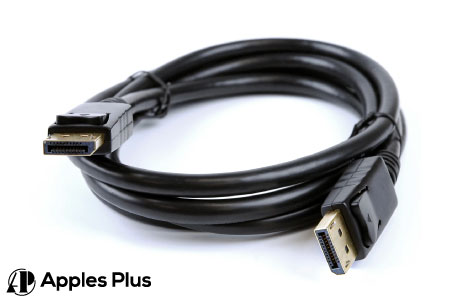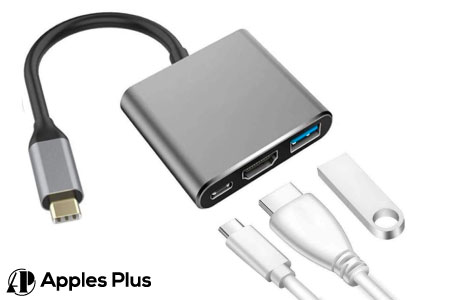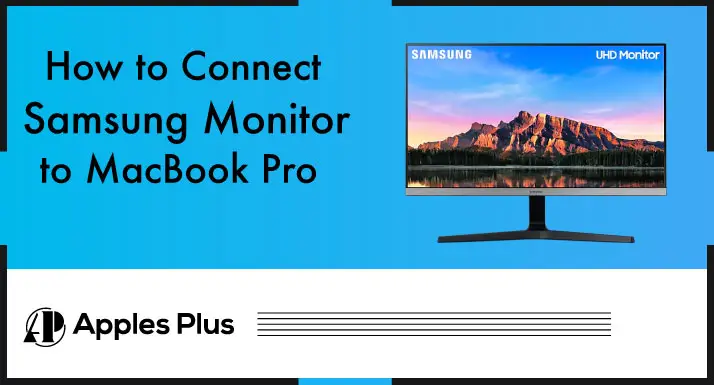In today’s digital era, many people work from home or use laptops for personal and professional use. As laptops have become more powerful, they have become the primary device for many users.
However, working on a small screen for an extended period can be tiring and may affect productivity. One solution to this issue is to connect your laptop to an external monitor.
This blog post will discuss connecting your Samsung monitor to your MacBook pro. It is a popular choice as Samsung monitors offer high-quality displays, and MacBook Pros are popular laptops professionals use.
Here, we will explore the various methods for connecting a Samsung monitor to a MacBook Pro and their pros and cons.
Connecting Samsung Monitor to MacBook Pro (Methods)
There are a few different ways to connect a Samsung monitor to a MacBook Pro, depending on the ports available on both devices. Here are some common options:
Connecting Samsung Monitor to MacBook Pro via USB-C Cable
USB-C is a versatile port that can be used for various purposes, including connecting external displays like a Samsung monitor to a MacBook Pro. Here’s how to connect your MacBook Pro to a Samsung monitor using a USB-C cable:

- First, check to see if your MacBook Pro has a USB-C port. Most newer MacBook Pro models have at least one USB-C port. You’ll need this port to connect your Samsung monitor.
- Check your Samsung monitor to see if it has a USB-C port. If it does not have a USB-C port, you must use an adapter or cable to connect it to your MacBook Pro.
- If both your MacBook Pro and Samsung monitor have USB-C ports, you can connect them with a USB-C to USB-C cable. If your Samsung monitor has a Thunderbolt 3 (USB-C) port, you can use a Thunderbolt 3 (USB-C) cable instead. If your Samsung monitor has a different port, use a USB-C to HDMI or DisplayPort adapter.
- Plug one end of the USB-C cable or adapter into your MacBook Pro’s USB-C port and the other into your Samsung monitor’s USB-C port or adapter.
- Once you’ve connected your MacBook Pro to your Samsung monitor using a USB-C cable or adapter, you may need to configure your display settings to ensure everything works correctly. Go to System Preferences > Displays on your MacBook Pro to do this. From there, you can choose your Samsung monitor’s resolution and scaling options.
That’s it! With a USB-C cable or adapter, you can easily connect your Samsung monitor to your MacBook Pro and enjoy a larger display.
Check our detailed review on Best Samsung Monitor for MacBook Pro.
Pros and Cons of USB-C Method
2. Easy to use
3. Audio support
4. Power delivery
2. Limited options
3. Expensive adapters
4. Not suitable for older monitors
Connecting Samsung Monitor to MacBook Pro via HDMI Cable
Here are the steps to connect a Samsung monitor to a MacBook Pro using an HDMI cable:

- First, check to see if your MacBook Pro has an HDMI port. Most newer MacBook Pro models do not have an HDMI port, so you may need an adapter to connect your Samsung monitor.
- Check your Samsung monitor to see if it has an HDMI port. Most Samsung monitors have an HDMI port.
- If your MacBook Pro has an HDMI port, you can use an HDMI cable to connect it to your Samsung monitor. If your MacBook Pro does not have an HDMI port, you’ll need to use an adapter that converts the MacBook Pro’s port to an HDMI port.
- Plug one end of the HDMI cable or adapter into your MacBook Pro’s HDMI port and the other into your Samsung monitor’s HDMI port.
- Once you’ve connected your MacBook Pro to your Samsung monitor using an HDMI cable or adapter, you may need to configure your display settings to ensure everything works correctly. Go to System Preferences > Displays on your MacBook Pro to do this. From there, you can choose your Samsung monitor’s resolution and scaling options.
That’s it! With an HDMI cable or adapter, you can easily connect your Samsung monitor to your MacBook Pro and enjoy a larger display.
Pros and Cons of HDMI Method
2. Audio support
3. Widely available
2. Limited options
3. No power delivery
4. Older technology
Connecting Samsung Monitor to MacBook Pro via DisplayPort Cable
Here are the steps to connect a Samsung monitor to a MacBook Pro using a DisplayPort cable:

- First, check to see if your MacBook Pro has a DisplayPort port. Most newer MacBook Pro models do not have a DisplayPort port, so you may need an adapter to connect your Samsung monitor.
- Check your Samsung monitor to see if it has a DisplayPort port. Most Samsung monitors have a DisplayPort port.
- If your MacBook Pro has a DisplayPort port, you can use a DisplayPort cable to connect it to your Samsung monitor. If your MacBook Pro does not have a DisplayPort port, you’ll need to use an adapter that converts the MacBook Pro’s port to a DisplayPort port.
- Plug one end of the DisplayPort cable or adapter into your MacBook Pro’s DisplayPort port or adapter and the other into your Samsung monitor’s DisplayPort port.
- Once you’ve connected your MacBook Pro to your Samsung monitor using a DisplayPort cable or adapter, you may need to configure your display settings to ensure everything works correctly. Go to System Preferences > Displays on your MacBook Pro to do this. From there, you can choose your Samsung monitor’s resolution and scaling options.
That’s it! With a DisplayPort cable or adapter, you can easily connect your Samsung monitor to your MacBook Pro and enjoy a larger display.
Connecting Samsung Monitor to MacBook Pro via USB-C to HDMI or DisplayPort Adapter
Here are the steps to connect a Samsung monitor to a MacBook Pro using a USB-C to HDMI or DisplayPort adapter:

- First, check to see if your MacBook Pro has a USB-C port. Most newer MacBook Pro models have at least one USB-C port. You’ll need this port to connect the adapter.
- Check your Samsung monitor to see if it has an HDMI or DisplayPort port. You may need to use a different adapter or cable to connect it to your MacBook Pro if it does not have either of these ports.
- If your Samsung monitor has an HDMI or DisplayPort port, you can connect it to your MacBook Pro with a USB-C to HDMI or DisplayPort adapter. These adapters convert the USB-C port on your MacBook Pro into an HDMI or DisplayPort port that you can use to connect to your Samsung monitor.
- Plug one end of the USB-C to HDMI or DisplayPort adapter into your MacBook Pro’s USB-C port and the other into your Samsung monitor’s HDMI or DisplayPort port.
- Once you’ve connected your MacBook Pro to your Samsung monitor using a USB-C to HDMI or DisplayPort adapter, you may need to configure your display settings to ensure everything works correctly. Go to System Preferences > Displays on your MacBook Pro to do this. From there, you can choose your Samsung monitor’s resolution and scaling options.
That’s it! With a USB-C to HDMI or DisplayPort adapter, you can easily connect your Samsung monitor to your MacBook Pro and enjoy a larger display.
Connecting Samsung Monitor to MacBook Pro via VGA Cable or Adapter
Here are the steps to connect a Samsung monitor to a MacBook Pro using a VGA cable or adapter:
- First, check to see if your MacBook Pro has a VGA port. Most newer MacBook Pro models do not have a VGA port, so you may need an adapter to connect your Samsung monitor.
- Check your Samsung monitor to see if it has a VGA port. Most Samsung monitors have a VGA port.
- If your MacBook Pro has a VGA port, you can connect it to your Samsung monitor with a VGA cable. If your MacBook Pro does not have a VGA port, you’ll need to use an adapter that converts the MacBook Pro’s port to a VGA port.
- Plug one end of the VGA cable or adapter into your MacBook Pro’s VGA port or adapter and the other into your Samsung monitor’s VGA port.
- Once you’ve connected your MacBook Pro to your Samsung monitor using a VGA cable or adapter, you may need to configure your display settings to ensure everything works correctly. Go to System Preferences > Displays on your MacBook Pro to do this. From there, you can choose your Samsung monitor’s resolution and scaling options.
That’s it! With a VGA cable or adapter, you can easily connect your Samsung monitor to your MacBook Pro and enjoy a larger display.
Pro Tip from the Gadgets Expert (Alex Harry)
It is difficult to say which method is the best for connecting a Samsung monitor to a MacBook Pro, as it largely depends on your specific needs and preferences. Each method has advantages and disadvantages; some may be more suitable for certain situations than others.
For example, the USB-C method is becoming increasingly popular as many newer Samsung monitors and MacBook Pros have USB-C ports, providing a reliable and fast connection. However, it may not be compatible with older devices or monitors that do not have USB-C ports.
On the other hand, the HDMI method is a widely-used standard compatible with many devices. Still, it may not support the highest resolution or refresh rates compared to other methods like DisplayPort.
Similarly, the DisplayPort method is preferred by some users for its support of high resolutions and refresh rates but may be less widely compatible with older devices or monitors.
Ultimately, the best method for connecting a Samsung monitor to a MacBook Pro will depend on your specific needs, such as the resolution and refresh rate you require, the compatibility of your devices and cables, and your budget. It is important to research and considers all available options to determine which method is best suited for your needs.
Why My Samsung Monitor Not Connecting to MacBook Pro?
There could be several reasons your Samsung monitor is not connecting to your MacBook Pro. Here are a few things to check:
1. Check Your Cables and Adapters:
Ensure you are using the correct cables and adapters for your setup. If you use an adapter, ensure it is compatible with your MacBook Pro and your Samsung monitor. If you need more clarification about the compatibility of your cables or adapters, refer to the user manuals or contact the manufacturer for more information.
2. Check Your Ports:
Check that your MacBook Pro and Samsung monitor are using compatible ports. If you use an adapter, ensure it is correctly plugged into your MacBook Pro and your Samsung monitor. Sometimes, ports can be damaged or dirty, so try cleaning them with a soft cloth or compressed air to ensure proper contact.
3. Check Your Display Settings:
Ensure your MacBook Pro is set up to display on an external monitor. Go to System Preferences > Displays and check that your Samsung monitor is selected as the primary display. If your Samsung monitor is not showing up, try clicking the “Detect Displays” button to refresh the display settings.
4. Check Your Monitor’s Power and Settings:
Ensure that your Samsung monitor is turned on and is set up to receive input from your MacBook Pro. Check that the monitor’s input settings are correctly set to the port you use to connect to your MacBook Pro. If your Samsung monitor has multiple input ports, try switching to a different one to see if that solves the issue.
5. Update Your Software:
Check that your MacBook Pro is running the latest software updates, which can sometimes fix compatibility issues with external displays. Go to System Preferences > Software Update and check for any available updates. If updates are available, install them and restart your MacBook Pro.
6. Try a Different Cable or Adapter:
If none of the above steps work, try using a different cable or adapter to connect your Samsung monitor to your MacBook Pro, as the problem could be with the cable or adapter you are using. Try using a cable or adapter you know works with another device to ensure the issue is not with your Samsung monitor or MacBook Pro.
Conclusion
In conclusion, connecting a Samsung monitor to a MacBook Pro can significantly enhance your computing experience by providing a larger screen, better resolution, and improved productivity.
We have discussed several methods for connecting a Samsung monitor to a MacBook Pro, including the USB-C, HDMI, DisplayPort, VGA, and adapter methods, each with advantages and disadvantages. While some methods may require additional adapters or cables, choosing the right method can significantly affect your display’s quality.
Ultimately, by understanding the various connection methods and their benefits, you can choose the best solution for your needs and create a seamless and productive work environment.

Meet Harry, the author of Apples Plus! Harry is a highly skilled electronic engineer passionate about testing and reviewing tech products like monitors and soundbars. With years of experience in the industry, Harry has developed a keen eye for detail and an in-depth understanding of the latest tech trends and developments.


